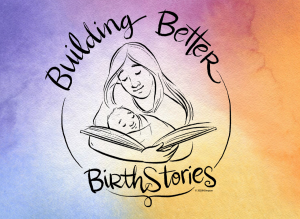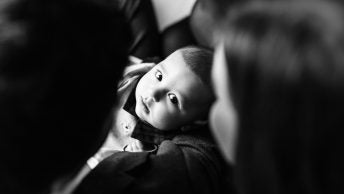In late August, I spoke with Hilary Simpson, a nurse working in maternal health in Reno, Nevada, to learn about her impactful project: Building Better Birth Stories. Her project underscores the importance of documenting childbirth narratives to improve maternal outcomes and also focuses on increasing communication among patients to build better birth stories. Hilary and I discussed her inspiration to start Building Better Birth Stories, her future plans for the project, and everything in between. Happy reading!

Yara: Can you start by telling me about your role as a nurse working in maternal health at Renown Medical Center in Reno, Nevada?
Hilary Simpson: I’m a labor and delivery nurse and have been on the unit for almost eight years now. I provide labor and delivery care including triage, antepartum, labor, C-sections and recovery in the Post Anesthesia Care Unit (PACU). I also float and occasionally work on postpartum and the Neonatal Intensive Care Unit (NICU).
Yara: What inspired you to start the Building Better Birth Stories project?
Hilary: When people hear what I do, they often tell me their stories. It’s always interesting to hear their experiences along with the emotions and impact of their story. Sometimes I hear about how birth stories could have been better, often a result of miscommunication and misunderstandings. I also can hear the fear and anxiety that some carry in their story.
The whole concept of Building Better Birth Stories came from my experiences with what we call crash C-sections, where the doctor says “we need to go now.” These are C-sections we do as fast as possible. I find them very stressful, and I always end up with a stomach ache afterwards. If I’m finding them so nerve racking, I know my patient is experiencing the scariest moment of their life. In the moment, there’s not much time to explain what we’re doing and why we’re doing it and this can set the patient up for trauma.
Afterward, I found myself intentionally delaying all my charting and documentation and standing at the bedside to talk with the patient and support person. I would ask them what they understood and how they felt. Then we would walk through what happened. We talked about what we did and why, their part, how well they did, and how they and baby are doing now. We talked about the feelings of fear, anxiety, disappointment, and frustration and the importance of including both the negative and positive feelings in their story. I try to make sure that the support person was at the bedside hearing this too, because I know the patient will probably not remember much of what I said. Between the two of them, my hope was that they heard and will remember some of our conversation. I hoped to help relieve some of their fear while validating their feelings including the disappointment that comes with having a C-section when they really wanted a vaginal delivery. I also wanted to make sure they understood medically what happened to them.
I started thinking of this communication as building better birth stories.
Yara: Can you tell me about Building Better Birth Stories, especially the journaling aspect of the project?

Hilary: There are a number of different small projects that are part of Building Better Birth Stories. As I realized how important it was to sit and talk with the patient, it was clear that there are many opportunities to improve communication with patients. They come to us with expectations, hopes, and fears. Patients need information and support. I started to look for places in our normal workflow where we can improve communication to build better stories.
Many of the projects involve prompting communication with the patient, so we are providing journals to our patients and encouraging them to write down their story. Journaling is a way that we can emphasize that their story is important. This is the best time to remember their story. Writing it down or sharing it can help them process their experience. If they can do that while they’re still in the hospital, they have us as a resource to answer questions and validate feelings. This processing may be particularly helpful for birthing people with traumatic deliveries. I think it’s something like 17% of patients will report a traumatic delivery who had what we would consider an uncomplicated and non-traumatic delivery.
At the same time we were doing that, we’ve also worked to improve our bedside report to incorporate more of the patient’s story. The report is a perfect opportunity where both nurses are there at the bedside with the patient, baby, and the support person, and we’re all already communicating. Involving all of us in sharing the story creates an opportunity to answer questions, build expectations, and validate feelings.
Ultimately, I plan to listen to our patients’ stories because that is the most important way for us to evaluate how our part of building the story is happening. The next step for the project is doing recorded interviews with our patients and asking them to share their story with us. We will get the opportunity to hear it and find places where we might have been able to build something better. We will keep evaluating and creating new ways to build better birth stories based on what the patients are telling us.
Yara: That’s great. How do journaling and documenting childbirth narratives affect maternal health outcomes?
Hilary: It’s not simply the writing and documenting. It really has to do with the formation of the narrative, and how they understand and feel about their story. We’re sending our patients home with a baby and a story. This story is about becoming a parent, a mother, and a father. The feelings and emotions that are part of this story have an impact on how they feel about the changes in their life and relationships. The formation of this story, how they understand and feel about it and how they tell it, impacts the entire family.
Let me give an example, imagine you have a birthing person who expected to go without an epidural and then decided to get epidural. They might feel like they failed and gave up. Then they start to try to breastfeed and it is never as easy as the pictures make it look. Then they get frustrated, reinforcing that sense of failure that started in the labor room. So could we have, in the moment, walked the patient through why getting an epidural is not a sign of failure? We should go through all the options making them an informed participant in their care. We can address the sense of failure, fear, and anxiety that might be associated with changing the plan of care. By doing this, we build confidence with them so that they are making an informed decision and that the patient feels and understands the best options for them and their baby. Then, when they get to postpartum, they may have more confidence in themself and in their decisions to work through the challenges of breastfeeding. We can empower them.
The story doesn’t end once the baby’s out. The birth story also expresses how they begin to bond and relate to their baby and how this new person impacts the family. It is a complex story relaying a medical journey, a major life change, role changes, expectations, hopes, fears and other associated emotions. As providers, we impact their story, what happens, how they understand it, and how they feel about it. There is an opportunity to improve how we do that.
The challenge for my project is figuring out ways to use these opportunities to improve care for every patient. Providing journals, improving bedside report, developing handouts given at admission to encourage conversation about expectations, providing presentations for nurses about the birth story, sharing our patients’ stories with each other, and considering opportunities to check in with our patients after they go home are all ways “Building Better Birth Stories” is trying to do just that. As we listen to more stories, we will build on our existing ideas and shape our workflow around the patient’s story.
Yara: How does childbirth education and shared decision making play a role into all of this?
Hilary: It’s huge! Right now I’m working with our childbirth education office, and we’re looking at offering a class to patients about the birth story. There’s an opportunity, as providers, to recognize how we can shape and clarify expectations. What does the patient understand and how can we better build and clarify expectations with our patients? The birth stories shared by friends, family, and media all impact what patients expect, which leaves a lot room for working with patients to set expectations and decrease fears and anxiety. There is also opportunity to build what a patient wants and hopes for in their story. The prenatal period is the best time to shape this with the patient. Then, when they are in the hospital, they have a foundation of information and education to participate in shared decision making.
Yara: I can imagine that when talking about birth stories in childbirth education, it sets up a support group so that they have other women who might have or will experience similar things.
Hillary: That is so important because if you have a story, you have to tell it. A story really becomes a story when you tell it. Whether or not you tell it to your mom, aunt, cousin, best friend; and whether you tell it once, twice, or 500 times (as I did with my birth stories), each person needs to talk through it and talk about it. The most important element of having a narrative story and processing it, is being able to tell it. Having others validate and encourage is part of processing the story.
One of the other elements of the project that we’re still working on is improved postpartum period care. We are going to trial a postpartum follow up-call. It’s a phone call at about two to three weeks after the baby is born to simply ask how the family is doing. If they want to tell their story, they can tell it. If they have questions, we can help answer them. It’s also an opportunity to see if they need to be guided to any resources. I think many birthing people and families get home with a baby and feel isolated. This limits the support the new family has and the opportunity to talk about the birth story. I suspect this is an even bigger challenge today because of COVID-19.
I put together a binder of resources that’s accessible to nurses during these phone calls. This way nurses can help connect patients to community resources. It includes basic information on helpful resources like the Special Supplemental Nutrition Program for Women, Infants, and Children (WIC), as a family who doesn’t have enough food or is worried about food will not be able to process their story at all. It also includes communities like lactation support groups to connect people. Furthermore, it’s an opportunity to ask about symptoms of depression and recommending they give their doctor a call. Being able to have that kind of contact afterwards is important in forming their story through each step – prenatal, intrapartum, and then postpartum. The birth story will be impacted when basic needs are not met or by postpartum mental health issues. Finding ways to help birthing people and families connect to the resources they need and to the community can also help build better stories.
Yara: How have birthing people and providers reacted to the Building Better Birth Stories project?
Hilary: I’ve been talking to my nurses about it for quite a while. In February, I did a presentation about birth stories, and how important our stories are to us. Our personal stories shape who we are, how we function in the world, and how we practice as nurses. By reflecting on our stories and our patients’ stories, we can examine how we provide care and how that might reflect in the patient’s story. I initially got good feedback. I’m really hoping that what has happened is that our nurses have taken the importance of the story to heart, and are using the concept to shape how they practice when they’re at the bedside.
Everyone has a story and understands how important their own stories are to them. We get so busy and focused on the situation and tasks at hand that important conversations and teaching may get lost. This is why this project is important, it helps to create space within our workflows that prioritizes the patient’s story. I think nurses and birthing people have to make this happen.
Yara: What are your future plans with the Building Better Birth Stories project?
Hilary: It’s an evolving project.
Right now it’s a project at Renown Children’s Hospital trying to figure out different ways we can build better stories. It is looking at what we can learn from listening to our patients and shaping our practices to meet their needs. Long term, I’d like to shape it into a program that can be shared with other hospitals and tailored to all the stories patients tell. Right now I’m focusing on what I can do at my hospital. However, I really like the idea of listening and evaluating and then implementing new tools and practices to impact stories as an ongoing cycle.
Yara: Is there anything else you want to add?
Hilary: I’ll tell you my favorite patient story that I like to use with this project.
I had a patient a while ago. When I took the report in the morning she was 36 hours into a long induction of her first baby. She and her husband had waited until later to have kids and she had some ideas and expectations of how this was going to go. She had had a rough pregnancy and didn’t enjoy it at all and – she was ready to not be pregnant. The pregnancy was nothing like she had expected, it was much harder. And now, labor was nothing like she expected. It was more painful than expected and she had opted for the epidural, which did not give her the anticipated relief. She was tired, frustrated and disappointed. So when she got to complete she was excited to move to the next phase, pushing. She enthusiastically started pushing but quickly got frustrated when delivery didn’t happen quickly. For 4 hours we pushed – we tried all the tricks – all the positions, all the breathing, and all the counting. She said at the 3 hour point “my sister went into labor and had a baby in the time I’ve been pushing.” She felt defeated. I told her “but that doesn’t matter because this is your story; it is your journey to becoming a mom, it doesn’t have to be like anyone else’s.” She expressed to me that she was failing at this, but she worked so hard and she moved that baby down little by little. With each bit of effort, encouragement was given. She eventually needed a vacuum assist, but she did it. She delivered her baby and she became a mother. When we transferred to postpartum, we went through all of it together: the experience, feelings and amazing job she did delivering her baby.
She came back a month later to talk with me. She thanked me and said the things we talked about kept playing in her head after the baby was born. She found these things helpful, and they became part of her story. Before she left I asked her how breastfeeding was going. She lit up, and told me that it was going so well and that she enjoyed it. She loved being a mom, saying it was so much more and so much better than she expected. You could see how excited she was about motherhood in that moment, and how much breastfeeding meant to her. Her story went through all the challenges of pregnancy and childbirth and she came out on the other side feeling empowered to be a mother.
And that is why we build better birth stories.
Yara: Thank you for sharing.

Hilary Simpson BSN RN-C has been a Labor and Delivery nurse for eight years at Renown Regional Medical Center in Reno, Nevada. She estimates that she has assisted in over 1000 deliveries and works to bring care, support, education, and equality to the bedside. She has her BSN and a bachelor’s in human development and family studies from the University of Nevada, Reno. She serves on the Womb to World committee at her hospital, a cross department collaboration coordinating quality care for families and babies and the perinatal bereavement committee serving Northern Nevada, supporting the needs of families who have lost babies during the prenatal period. She is a wife and a mother of three teenagers and two dogs.



